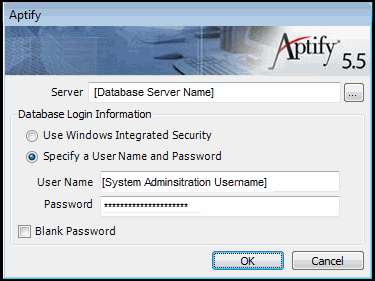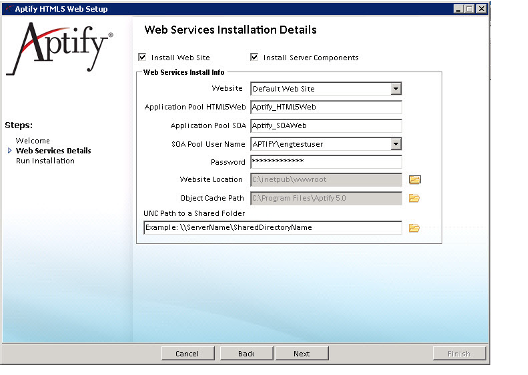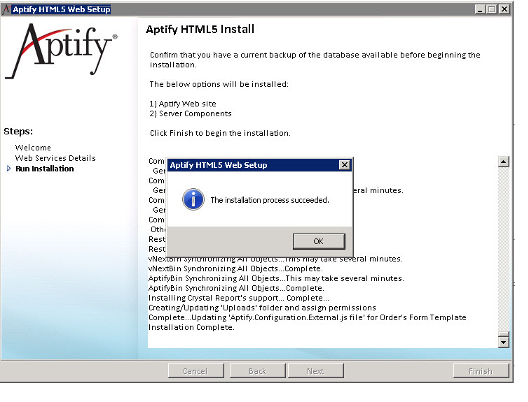This topic describes how to install the Aptify site on a web server so users with trusted accounts in Aptify can access the system using a supported web browser.
To do this, perform the following steps:
Note
The Aptify web interface should be installed and tested on a non-production environment first before applying to a production web server, just as if you were installing an Aptify Service Pack.
Be sure to back up the server where you will install the production Aptify web server, to provide a fall-back option, in case a problem occurs during the Aptify web site installation.
- Confirm that the database server has the same version of Aptify as the version you are installing on the web server (i.e., the database server has Aptify 5.5.1, and you are installing the Aptify 5.5.1 on the web server). This is a pre-requisite before you can install the Aptify site.
- Identify the web server that will host Aptify. This server must meet the requirements specified in Server Requirements for the Aptify Web Interface.
- If the web server is installed on a different computer than the database server and you have chosen to use Windows Authentication, confirm that your network is configured to support delegation. See Aptify Site and Network Delegation for details.
For web servers that will be available over the public Internet, you should install and test the Aptify site within the firewall first before moving the web server outside your organization's firewall.
For web servers that will be available on the public Internet, you must secure the site using HTTP over a Secure Socket Layer (SSL) to create an HTTPS site. The default installation of the Aptify site requires SSL. The site will not load successfully unless the site is configured to use SSL. See Securing the Aptify Web Site Using SSL for additional information.
- Create a new domain account or identify an existing domain with a valid license account to use on the Aptify web server.
- This is the user account that Aptify (SOA layer) uses to communicate with the Aptify database server.
The account must be a trusted user with a valid license on the Aptify database server with the appropriate privileges to conduct Aptify activity.
Per packaging requirements for this version, the Application Pool Identity used by the Aptify web site is set to LocalSystem and the identity used by the AptifyServiceAPI (SOA layer) site is set to run as the user specified in the setup program.
Log into the web server using an account with administrative privileges.
It is highly recommended that the user account used for the SOA layer is not used to log into the Aptify web server. If the SOA layer user account is used to log into the web server, you may need to reset Microsoft IIS to restore features such as reporting.
- Determine whether the web server has the following software installed:
- Aptify 5.0 Desktop client
- Microsoft .NET Framework 4.5
- ASP .NET MVC 4
- If the Aptify 5.0 Desktop client is not installed on the web server, install it. See Installing the Aptify Desktop Client.
- The client application provides the active Aptify Object Repository service used during the installation process.
- The client application provides the active Aptify Object Repository service used during the installation process.
- If Microsoft .NET Framework 4.5 is not installed on the web server, download and install it from the following URL:
http://www.microsoft.com/en-in/download/details.aspx?id=30653 - If ASP.NET MVC 4 is not installed on the web server, download and install it from the following URL:
http://www.asp.net/mvc/mvc4
- Download the Aptify installation ZIP file to a folder on the web server and unzip its contents.
- Run the installation program locally on the web server that will host the Aptify site; do not run it over the network.
- Run the installation program locally on the web server that will host the Aptify site; do not run it over the network.
- Browse to the location of the installation files, right-click the Setup application file, and select the Run As Administrator option to launch the installation program.
- On Windows Server 2008, the Run as Administrator option bypasses the server's User Access Control (UAC) for the duration of the installation.
- On Windows Server 2008, the Run as Administrator option bypasses the server's User Access Control (UAC) for the duration of the installation.
- Review the set of requirements to install. If your environment does not meet one or more of the specified requirements, click Cancel to abort the installation. Otherwise, click Next to continue.
- See Server Requirements for the Aptify Web Interface for more information on the Aptify site requirements.
- See Server Requirements for the Aptify Web Interface for more information on the Aptify site requirements.
- Click Next to continue.
When prompted, enter login information for the database server, specifying an account with system administrator privileges (such as sa).
- Click OK to continue.
- Review the installation details and select one of the following options:
- To install only the Aptify site, ensure that the Web Site option is selected and the Install Server Component option is cleared. This option is only applicable if you have previously installed the Aptify Server Components on the Aptify database server.
- To install the Aptify web site and the Aptify server component, keep both options selected.
- To install only the Aptify server components, ensure that the Web Site option is cleared and the Install Server Component option is selected.
- This option installs the necessary entities and metadata on your database server.
- While you can run the installer multiple times to create multiple Aptify sites that communicate with the same database server, you should only install the necessary entities and metadata on your database server once.
- Select the Website under which the Aptify site will be hosted.
- Default Website is selected by default, however you can host the Aptify website under another site. The site must be manually created through the IIS Manager prior to running the Aptify web site setup.
- Default Website is selected by default, however you can host the Aptify website under another site. The site must be manually created through the IIS Manager prior to running the Aptify web site setup.
- Enter the Application Pool name to be used for the Aptify web site.
- The default application pool name is Aptify_HTML5
- Per packaging requirements for this version, the Application Pool Identity used by the Aptify web site is set to LocalSystem.
- Enter the Application Pool name to be used for the Aptify SOA site.
- The default application pool name is Aptify_SOAWeb
- The default application pool name is Aptify_SOAWeb
- Specify the trusted user account that you want to use for the Aptify web site in the SOA Pool User Name field.
- Enter the password for this user in the Password field.
- Specify the location where the Aptify web site files should be installed on the web server in the Website Location field.
The default installation path is c:\inetpub\wwwroot and the Aptify folder is created automatically.
For example, if you want to use the location aptify1 rather than aptify, in the default location, you will need to create a folder called aptify1 under c:\inetpub\wwwroot.
Note Concerning Aptify SOA Site
The default installation path of the Aptify SOA layer is c:\inetpub\wwwroot\ and the web folder is AptifyServicesAPI. The path and location can be modified manually once the Aptify web site is installed.
- Select the location in which the Aptify Desktop client is installed in the Object Cache Path field.
- The default location is C:\Program Files\Aptify 5.0.
- The default location is C:\Program Files\Aptify 5.0.
- Enter a location on the SQL Server to which your user account has read/write access in the UNC Path to a Shared Folder field. (This is the Windows domain account you have used to log into the web server.)
- You must enter the location's path in the UNC (Universal Naming Convention) format. The location should be a shared drive or folder on the SQL server.
During installation, the installer copies certain assemblies to the server location you specified. Therefore, the account currently logged into the web server must have read/write access to that location on the database server.
- Click Next to continue and review your installation options.
- Click Finish to begin the installation process.
- Click OK when prompted that Aptify has been successfully installed to close the installer.
- If a problem occurs during the installation, the Aptify Installer will notify you that an error occurred. See What to Do If the Aptify Site Is Not Installed Correctly if the install is not successful.
- If a problem occurs during the installation, the Aptify Installer will notify you that an error occurred. See What to Do If the Aptify Site Is Not Installed Correctly if the install is not successful.
- Restart the IIS service.
- Although technically not required, restarting the IIS service will ensure that all existing sessions connected to the web server are terminated before the website is used.
- You can restart the IIS service from either the Internet Information Service (IIS) Manager or from the Windows Services dialog.
- Connect to the Aptify web site to confirm that it loads properly using a supported web browser.
- By default, this step assumes that you have a user account (trusted or untrusted) with a valid license in Aptify.
- If connecting to Aptify directly from a web server that is not in a nested (hierarchical) domain, enter the following address: https://localhost/Aptify
- If you accepted the default virtual directory name, enter http://localhost/aptify
- If you accepted the default virtual directory name, enter http://localhost/aptify
- If connecting to Aptify directly from a web server that is in a nested (hierarchical) domain, you must address it with the fully qualified domain, such as: http://server.teir2.teir1.com/aptify
- If connecting from another computer on the network, then enter http://[server name]/aptify in the browser window.


